Growing cucumbers in the winter at home is a fairly common practice. But such an activity requires some effort. These plants are very fond of light and heat, which necessitates the placement of pots and garden beds on the sunny side of the apartment. The average room temperature should not be lower than +20 degrees Celsius. In winter, you will have to apply additional lighting, as natural light will not be enough.
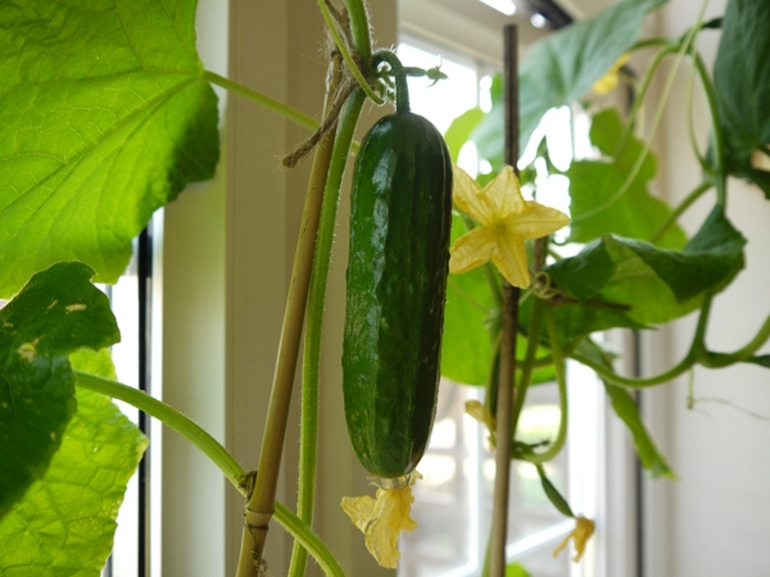
Content
The choice of cucumber varieties
Although the cultivation of garden plants in the apartment is a frequent occurrence, still grow cucumbers on windowsill in winter pretty hard. For home growing, there are certain special varieties that are self-pollinating. They also give a fairly high yield and ripen very quickly. Often these are hybrid varieties. Such species are denoted by the symbol F1, which means that they are heterotic. Sprouts are usually very different from a standard plant.
Parthenocarpic hybrid is great for growing cucumbers in an apartment in winter. It is a gherkin that has female inflorescences. This variety does not require pollination.
You can grow cucumbers in an apartment in the winter and other species. For this purpose they are most suitable:
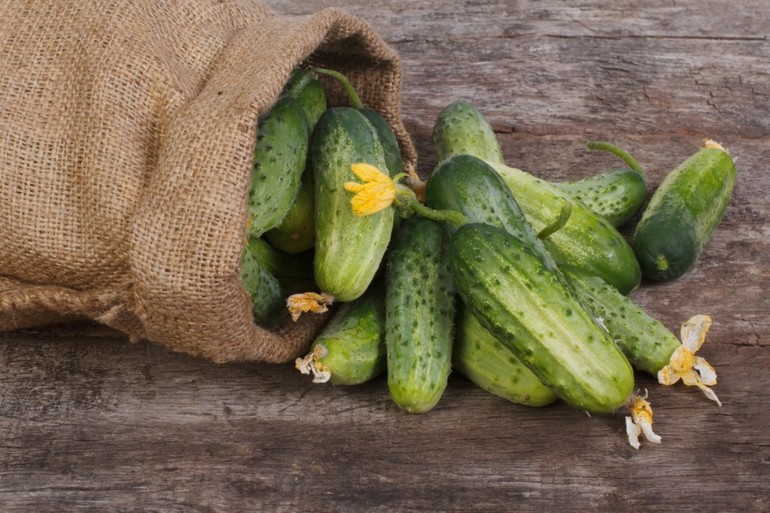
- Farmhouse.
- Claudia
- Room Rytova.
- Masha.
- Bianca
- Generous.
- Marinda
- Prestige.
All of these varieties have the prefix F1. Masha F1 is necessary for ripening from a month to 40 days. It has a high yield (up to 20 pieces from one branch). Shchedryk F1 ripens longer - from 40 to 45 days. The average size of the fetus varies from 12 to 14 centimeters. The yield is the same as in the previous variety. Marinda F1 differs from the rest in that all the fruits ripen at the same time.
Khutorok F1 ripens relatively quickly (approximately 30 days). The average size of each fruit is 10 cm. Cucumbers have a pronounced green color, as well as black spikes.
The F1 crystal ripens for approximately 50 days. Productivity reaches 7 cucumbers from one branch. It differs from other varieties by its tallness, so it is often used to decorate a balcony. If you create good conditions for the plant, then up to 40 cucumbers are usually collected from one bush.
Crockery and soil
To grow seedlings from seeds, the best option would be to use plastic cups of small volume (for example, jars of sour cream or yogurt are suitable), pots filled with special soil or containers of peat. There should be several small holes in the bottom.
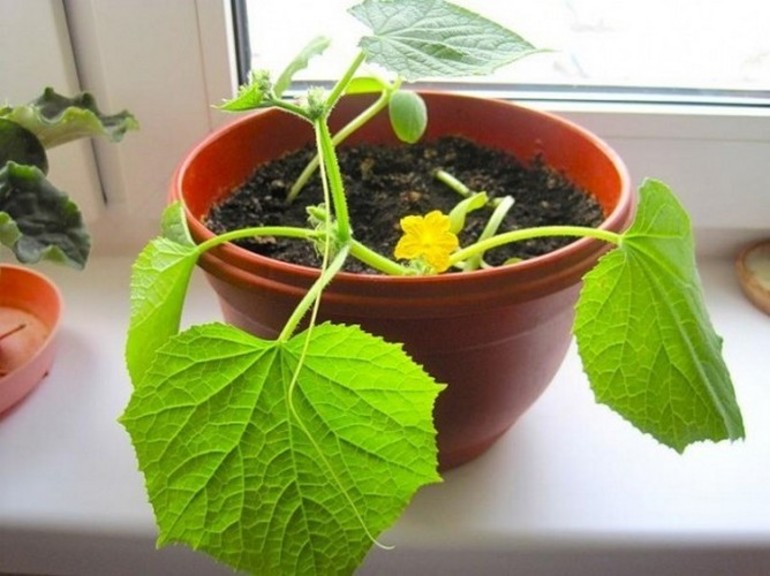
When the time comes for growing full-grown bushes from seedlings, it will be necessary to use containers with a capacity of about 5 liters. To do this, usually use plastic pans, deep drawers, as well as small buckets. Below, it is also necessary to make holes that will ensure an adequate level of ventilation and water drainage. At the bottom it is necessary to lay a drainage layer. For this purpose, fine pebbles or ordinary sand are suitable. The thickness of this layer should be approximately 5 cm. Then the earth is poured.
Choosing the right soil is very important. In specialized stores you can easily find the necessary land, which is enriched with all the minerals and other substances needed by the plant.You can also consult with specialists there. Experts quite often prepare the ground on their own.
For example, the recipe could be like this:
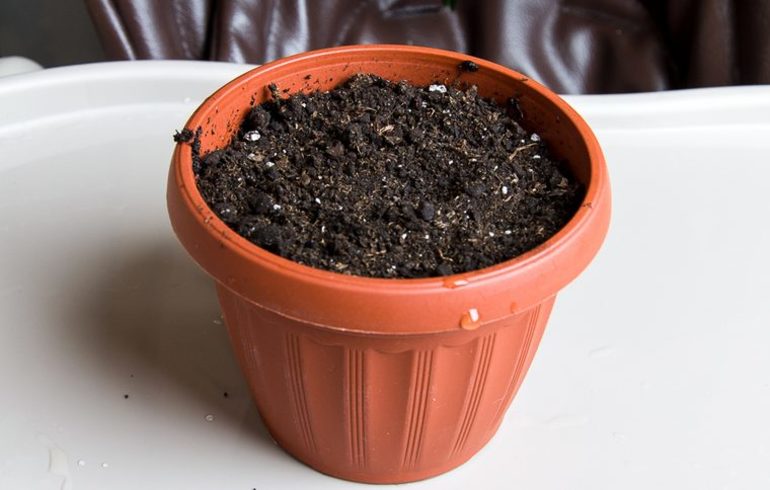
- It is necessary to pour 2/3 of the usual garden soil into the tank, but before that it must be decontaminated with a manganese solution.
- 1/3 of the capacity is fertilizer. Added nitrogen, potassium and phosphorus of 5 grams. You should also add about 40-50 grams of lime, and fill the rest with humus.
- 1 cup of chalk, 4 cups of rotten leaves or sawdust and 2 cups of ash are added.
It is advisable to prepare such soil in advance. It needs to be warmed up well in the oven to destroy all the eggs of the parasites. Then the mixture is poured with water.
Seedling preparation
Seeds must be soaked in advance in a very weak solution of potassium permanganate. Planting dried seeds, or the way they are, is also practiced. Grains are grown in some plate, which must be left in a dark place where the temperature does not drop below +25 degrees Celsius. When small sprouts up to 1 cm in size appear, they must be planted in small glasses or pots filled with soil. Then they need to be moved to a bright place and carefully covered with plastic wrap. The temperature in the room should not fall below +20. Periodically, the seedlings are watered and fed.
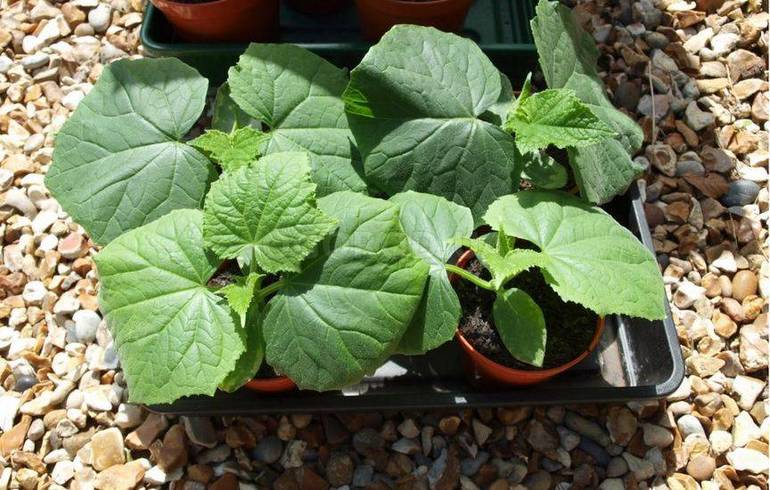
When normal leaves appear, seedlings will need to be transplanted in larger containers. This should be done very carefully so that the roots of future bushes are not damaged. If the seedlings are in peat glasses, then they can be transferred to large containers directly in this form.
At this time, cucumbers need special care. When 4-5 leaves appear, the first pinching should be done, and after 6 - the second. Next, the pinching of the main stem is performed over the 11th leaf. In the future, you need to remove the side shoots as they grow, as they take away the strength of the entire plant, which entails a decrease in yield.
It should be remembered that cucumbers are very moisture-loving vegetables, so plants need to be sprayed with water from any sprayer at least once a week. It is necessary to use only settled and warm water. It should be watered as the top layer of the earth dries. Excess moisture can only harm cucumbers. If the plant is located on the balcony, then there is a risk of dehydration, since there is often quite dry air. To prevent this from happening, it is better to place any container with water nearby.
To ensure the normal growth of seedlings, good lighting is necessary. In winter, additional artificial light is required. Infrared lamps work best on plants. They should be turned on for at least 12 hours every day. At night, they turn off.
There are homemade varieties that require pollination. In this case, this procedure will have to be carried out independently. For this, it is necessary to pluck male inflorescences and pollinate female ones. You can also use a brush or a regular cotton swab to transfer pollen.
Feeding seedlings
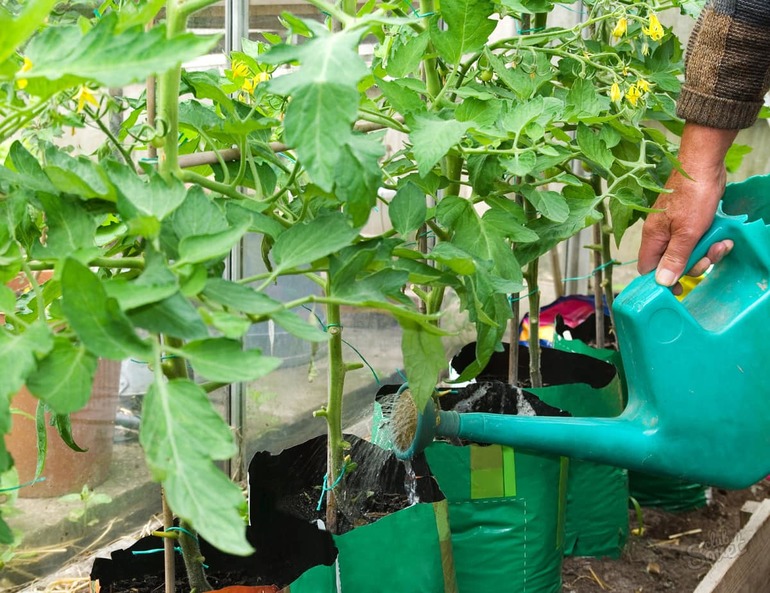
During the cultivation of cucumbers in the winter, it is imperative to regularly feed the plants with fertilizers. On average, you need to do this every 10 days. Any organic fertilizer is perfect. It is necessary to use an infusion made from the peel of bananas in a ratio of 1 to 10. After the buds begin to appear in the plants, a solution of wood ash should be used. The proportion is the same. When the cucumbers begin to ripen, it is advisable to add mineral fertilizers. They should be periodically alternated with organic.
If the plant suddenly weakened, then a special non-root supplement of useful minerals should be used. To make the right solution, need to prepare:
- 10 liters of water.
- 10 grams of urea.
- About 15 grams of double superphosphate.
- 3 grams of sulfuric magnesium. You can also use the mother liquor.
This mixture must be prepared 24 hours before use. It needs to be constantly stirred. Strain preferably through several layers of gauze. Bushes are thoroughly sprayed with the prepared solution. After the procedure, there will be salt residues on the leaves. They must be removed with clean water.
Diseases and Pests
Ripe fruits must be harvested every day as they mature. It is not recommended to leave the cucumber on the bush, because this way it will take excess power from the plant.
If you follow all the recommendations and conditions, then growing cucumbers in the winter in the apartment is quite simple. You can provide your family with fresh vegetables throughout the year. And also it will allow you to get a huge amount of positive emotions directly from the cultivation.
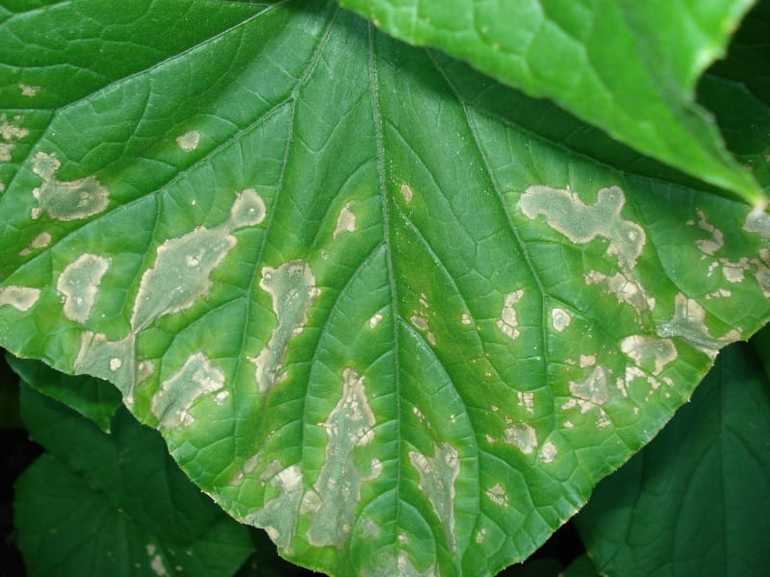
But in the process, plants can get sick and die. Home conditions do not guarantee that cucumbers will not be damaged by the attack of all kinds of pests. Any violation in the cultivation technology can lead to various diseases. For example, constant stagnation of moisture in the ground can lead to rotting of the roots, and this will lead to the death of the cucumber.
Leaves may be damaged due to attack by aphids, spider mites, or common whiteflies. Home conditions do not allow the use of special insecticides, as this can damage the health of households. Quite often to protect plants apply folk remedies:
- Aphids and whiteflies simply destroy with the help of tobacco infusion.
- The spider mite dies if the plants are sprayed with garlic tincture, to which antibacterial soap must be added.
Yellowing foliage
Often at home, the plant may begin to wilt. The first sign is yellowing of the leaves. Most often, this problem occurs due to illness or inappropriate care. Main reasons:
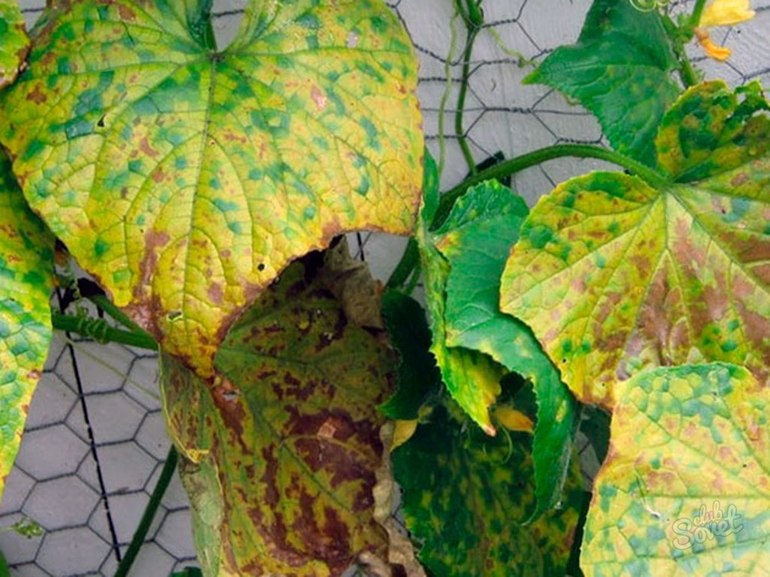
- Too much moisture. No need to water the cucumbers too much. This should be done only during planting. Then watering is carried out approximately once a week. Water should be cold, room temperature. It is advisable to spray the leaves and stem superficially every two days to maintain the necessary moisture level. In some cases, people pull polyethylene onto a window. This allows you to create a greenhouse effect.
- Quite often, the cause of yellowing and drying becomes a lack of moisture. In this case, the plant specifically delivers less water to the leaves in order to save and preserve itself. The humidity level in the room should be at a sufficient level.
- Chlorophyll deficiency also causes yellow leaves. To correct the situation, you should pour cucumbers with a solution of complex fertilizers. Their composition should include nitrogen, magnesium and iron.
- Leaves of house cucumbers deteriorate due to parasites and diseases. An insect can be seen if you carefully examine the entire stem or foliage. Aphids start with the brought earth. If cucumbers get sick, then you definitely need to find out what exactly.
- Huge damage to cucumbers causes sprout fly. To avoid its appearance, you need to disinfect the ground before planting. If larvae were found, then the plant will have to be transplanted into new soil.
- Cucumber can also disappear due to root rot. Such a disease is fungal. The root system begins to rot, which leads to drying, and then to death. Prevention is to maintain a normal level of humidity.If the plant is already affected by this disease, then you should add fresh earth to the pot. This will allow the formation of new roots.
Compliance with the rules and recommendations most often prevents the development of diseases and the appearance of pests. But even experienced gardeners sometimes lose their entire crop. To prevent this from happening, you need to take action on time.
 You may be interested in:
You may be interested in:Points for and against
Cucumber is a world famous vegetable plant. Almost all summer residents grow it in their gardens. For women, it is not only a delicious vegetable, but also a product from which masks are made to rejuvenate the skin.
It must be remembered that growing cucumbers in the house entails certain inconveniences:
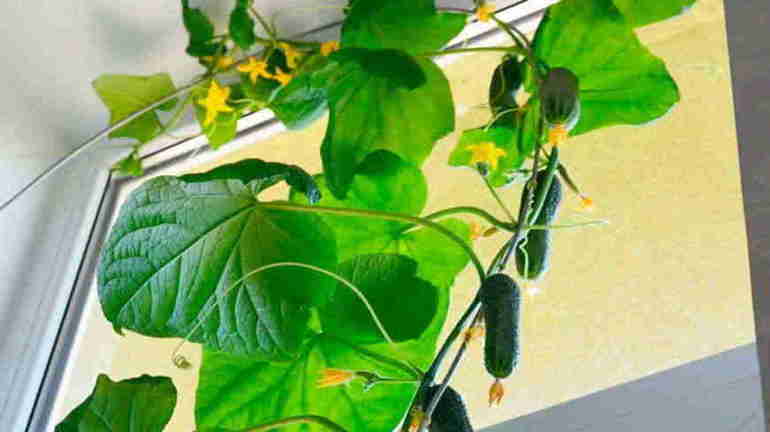
- The apartment will have to increase humidity.
- A specific smell of soil will be felt.
- Every day will be provided with chores. Plants will have to be watered and tied in time.
- Some people may experience allergic reactions.
Living space must be sacrificed for breeding plants. They have a fairly large tops, which will block the sunlight. And in winter it is not enough. Living in your home will have to be in constant twilight and with high humidity.




 Armenian cucumber with melon flavor: description and characteristics, reviews
Armenian cucumber with melon flavor: description and characteristics, reviews Do-it-yourself vertical beds for cucumbers: schemes, photos
Do-it-yourself vertical beds for cucumbers: schemes, photos Hollow cucumbers: reasons for the appearance of hollow, what to do
Hollow cucumbers: reasons for the appearance of hollow, what to do Which manure is best for cucumbers: application, how to breed
Which manure is best for cucumbers: application, how to breed